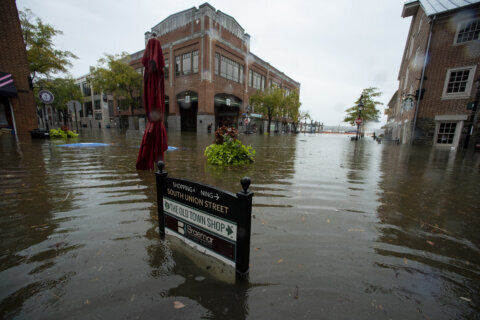The National Weather Service’s mantra “Turn Around Don’t Drown,” which strives to convey the seriousness of flash flooding and the action drivers should take when faced with a water-covered roadway, is a catchy slant rhyme and an important rule of thumb.
In metro areas where traffic is often heavy, however, turning around is easier said than done.
When the skies unleash extreme rainfall and a Flash Flood Warning is issued, drivers should take action immediately. Roads that dip into valleys, span low-water crossings or parallel streams should be avoided as water levels will rise suddenly. Find higher ground and consider waiting there until the heavy rain subsides and the water recedes into storm drains.
On flood-prone roads at creeks like Woodburn Road in Annandale, Virginia, or Bradley Boulevard in Potomac, Maryland, turning around is easy. There’s no excuse to charge into swift water; you risk totaling your car and losing your life. The submerged road could be washed out. Turn around.
What do you do, however, if you find yourself on a limited-access highway or one-way road? It’s possible to become stuck between rising floodwaters and bumper-to-bumper traffic on guardrail- and wall-lined highways and byways without a way to turn around or escape. This happened on Canal Road in Northwest D.C. on July 8, 2019 to several drivers.

Those who encountered flooding wisely braked at the water line, but were blocked by the backup. They could only watch as the flash flooding overtook first the wheel wells, then the hood and eventually the cabin of their car.
Don’t panic. Try to gesture or signal to the drivers behind you with your hazards and backup lights that you are in danger. If the queue of traffic can reverse even a few dozen feet, the reversal of traffic may prevent the submersion of the vehicles closest to the flood.
It’s unlikely police or authorities will arrive at the scene to direct traffic in time. Do not attempt to drive the wrong way down a highway unless you are truly in a life-threatening emergency.
If water is filling the interior of your vehicle, as a last resort, roll down your windows or sunroof and be prepared to evacuate your vehicle. The NWS says if floodwaters rise around your car, to abandon the vehicle and move to higher ground if you can do so safely. A foot of water will float many vehicles.
Again, these drivers managed to reverse after venturing just past the point where Broad Branch spilled out of its banks. pic.twitter.com/mrugeUEp9w
— Dave Dildine (@DildineWTOP) July 25, 2018
Flooding on urban highways is usually the result of excessive runoff from impervious surfaces overwhelming the storm drainage system. It is usually, but not always, still or slow moving water. Still-water flash flooding can cause loss of property, but won’t result in loss of life when the proper actions are taken. Assess the risks and use common sense.
Remain put on higher ground until the threat passes. Flash flooding occurs quickly, but recedes nearly just as fast. When the heaviest rain ends, the storm drains and creeks will begin accepting the runoff.
Some larger tributaries around the region, such as Rock Creek, will rise as much as an hour later when the heaviest rains occur upstream. This often leads to delayed flash flooding and water level rises along Beach Drive near Porter Street and Rock Creek Parkway near Waterside Drive.
Flood emergency continues in #EllicottCity with road, structure damage on Main Street pic.twitter.com/Yv6CCWTp00
— Dave Dildine (@DildineWTOP) May 27, 2018
Preparation is the first step a driver can take to keep themselves safe in torrential rain. A Flash Flood Watch means conditions that could lead to flooding are possible. A warning means that flooding is immanent or occurring. When a watch is issued, plan to take an elevated route that does not cross or dip into a watershed like Rock Creek Park, Difficult Run, or the Northwest Branch of the Anacostia River. If a warning is issued for your area before you depart, consider postponing your trip.
Local roads that meander through stream valleys and that are notorious for flash flooding include Beach Drive, Sligo Creek Parkway, Broad Branch Road and Goldsboro Road along Minnehaha Branch. These roads become waterways during excessive rainfall and should always be avoided when a Flash Flood Warning is in effect.








